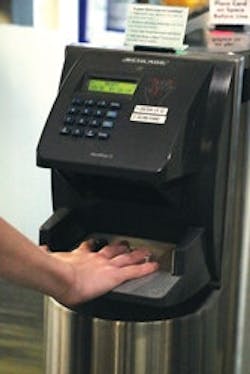While biometric security has traditionally been used for highly sensitive buildings and areas, more facilities are now leveraging its technology for the optimization of daily facility operations.
Could biometric access control help your building run more efficiently?
Falling Costs of Biometrics
Biometric technology has become much more affordable over time. It’s now available on nearly every phone and tablet.
“The fingerprint technology seems to be leading the charge for the scale of deployment because it’s less expensive when compared with other biometric authentication technologies,” says Ilya Umanskiy, Head of Diversified Solutions at Integrated Systems & Services. “That’s the key issue the industry has been struggling with for years: the speed of processing. Biometrics wasn’t popular in the earlier stages of the technology because of kick outs and delays, but the accuracy and processing speed have improved.”
The improvement in speed and accuracy of biometric technology has led to its widespread adoption. The industry has been able to align convenience and security so they aren’t in opposition anymore. Cost has also fallen for all types of biometric technology.
“When I started looking at the iris technology in 2008 and 2009, it filled about half an office, used six cameras and cost a quarter million dollars,” says Mark Clifton, CEO and president of Princeton Identity, a biometrics manufacturer. “Now it can be done with a Samsung phone. The cost of readers is headed in that direction as well.”
Readers are the most expensive part of implementing biometrics, as they can cost 30 to 40 percent more than traditional RF readers, explains Umanskiy. You should decide whether the cost of biometrics has fallen enough for use in your facility based on a combination of your budgetary constraints and security requirements.
Balancing the Precision of Identification
The main selling point for biometrics is that it provides more security in the identification process, which can provide stricter access control and a lower margin of error than other forms of identification.
[Related: Implement These Security and Access Control Tips]
Biometrics provides better security than RFID cards or pin codes because you cannot transfer your fingerprint or any other identifying physical characteristic to another person, explains Clifton.
Related Content
Of course, different physical characteristics have different levels of precision. For example, irises provide more information unique to the individual than fingerprints or handprints. Compared to fingerprints and hands – the two most common types of biometric technology – irises contain significantly more information.
The chances of an imposter getting in are low with iris scanning, explains Clifton.
However, that level of identification isn’t right for every building. In some instances, you might simply be trying to improve flow in and out of the facility. In that case, you wouldn’t necessarily need identification of that level.
To identify the best kind of readers in your facility, you will need to determine how sophisticated you need your technology to be, how much you want to spend, and what will work best with your building’s occupants.
Eliminating Vulnerabilities in Design and Integration
Despite costs going down and improvements to the technology, biometrics still comes with its own set of limitations – foremost being the issue of cybersecurity.
“There’s always the issue of cybersecurity. It’s the same issues you have with any private information,” says Clifton. “You don’t want it out there and spread around. Cybersecurity becomes one of the Achilles’ heels of biometrics. How you secure the information is important.”
Therefore, it is vital to work with a manufacturer that actively works to secure your facility’s and occupants’ data. Then, in your design and implementation, you want to be sure that the information picked up from the reader is securely transmitted to a server and is encrypted. This is where many manufacturers fall short.
“When people deploy biometrics, they often use the biometric reader to do everything like lock the door itself,” says Bill Giehler, director of operations at Integrated Systems & Services. “They just use the biometric reader without an external relay, meaning all someone has to do is knock the reader off the wall to get through the door. You need to connect it to a secure device in another location that unlocks the door.”
Most of the problems with biometric security and access control come from poor planning during the design and integration process. Many organizations are just integrating biometrics to achieve compliance, but end up undermining the system itself by using either sub-standard products or poorly configured systems, which is a waste of money and creates a security vulnerability.
It is important that you don’t rush through the decision-making process, thereby ignoring any possible vulnerabilities, Umanskiy explains. You can saturate a building with technology, but incompetent design and integration will leave your system at risk of an ill-intentioned person manipulating or circumventing your biometric system.
Justin Feit was an associate editor of BUILDINGS.
Two handpicked articles to read next:
